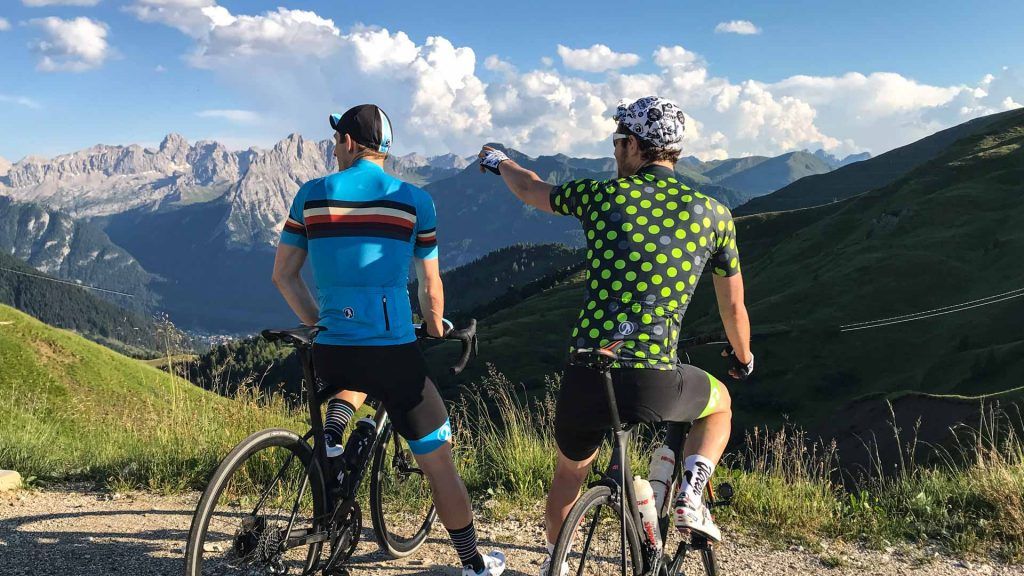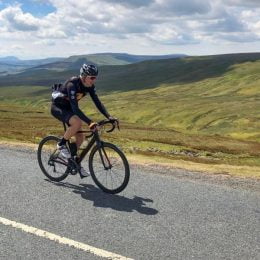The Blue Route runs to the south and west of Oudenaarde and is the shortest ride of the three signposted routes. But if you want to get straight into those famous cobbled climbs then start here because within the first hour or so you will have encountered none other then the cobbles of the Oude Kwaremont, the Paterberg and the famous Koppenberg climb – a short sharp welcome to a Flanders cycling route!
Having conquered these initial bergs you can’t help but feel captivated by Flandrien cycling and this part of the world – you feel you’ve arrived somewhere very special.
This ride also gives you your first introduction to a well used and worn cobbled road namely Mariaborerestraat – pan flat for nearly 2.4 kilometres and a completely different challenge to riding uphill as you’re travelling more quickly and as such balance and bike handling skills become more of a factor.
We felt the Blue loop was the perfect introduction to a cycling tour of Flanders and later celebrated with a bottle or two of the local Kwaremont beer which incidentally contains 6.6% of alcohol and apparently matches the gradient of a particular part of the climb!
All metrics in this article are approximate.
Highlights
The high point for us can be summed up in one word – Koppenberg. We had heard so much about it, read about it, seen it each year on television and watched numerous videos about those famous 682 cobbled meters. We both felt our heartbeat increase and the hairs on our neck stand on end as we approached the village of Melden. And there it was – very understated and lacking any form of fanfare – a simple sign, white on brown that simply said ‘KOPPENBERG’. With a rush of adrenaline, we swung into the climb thinking of Cancellara, Sagan, van Avermaet and Boonen.
That was before the gradient hit, our speed decreased to a virtual standstill and our legs started screaming with every pedal stroke…
But around four (long) minutes later there was huge relief and exhilaration as we stopped at the summit. We had conquered the Koppenberg – and it felt great.
NB Incredibly, local professional Dries Devenyns of Quickstep took only 1 minute 40 seconds to complete the Koppenberg climb and at the time of writing holds the record. It took us “a little” longer.
 At the bottom of the Koppenberg climb
At the bottom of the Koppenberg climb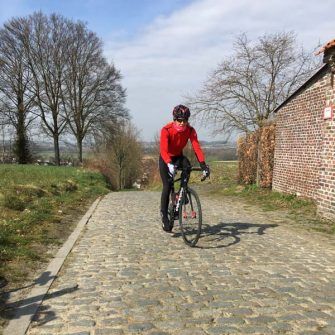 Pushing on up the Koppenberg
Pushing on up the Koppenberg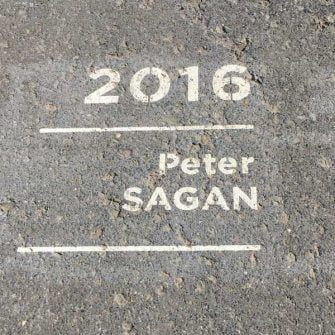 Road markings that are likely to induce goose bumps!
Road markings that are likely to induce goose bumps!Route notes
1. Oudenaarde to Oude Kwaremont and Koppenberg: 0-23 km
The first few kilometres are flat and gentle and are perfect for getting into the ride. At just under 10 kilometres you leave the river path and swing left to approach the Oude Kwaremont.
Oude Kwaremont – this is a 2.5 km semi-cobbled climb at an average gradient of 3% with a maximum of 11%.
It is also one of the most famous Flemish hills due to the fact that it is often ridden three times during the Tour of Flanders so it is seen more than most climbs on television. The Oude Kwaremont climb is not the steepest of climbs, but the third ascent is strategically placed towards the end of the race. The road then meanders north through narrow and twisting country roads and lanes and within the space of the next 10 kilometres or so you will encounter:
Kalkhoveberg – 250m asphalt descent at 14% (max 18%)
Paterberg – 361m cobbled climb at 12% (max 20%)
There is a 60 cm rainwater gutter that runs all the way up the left-hand side of the Paterberg. If you need a short break from the bone-shaking cobbles, then it’s an option! Unfortunately for the professionals, in the race, the crowd barriers are placed in this area meaning there is no escaping from the cobblestones.
The locals tell you that the reason the Paterberg was eventually included in the Tour of Flanders was that a wealthy farmer who lived on the berg was irritated that all the action and publicity in the race was centred on the nearby Koppenberg, so he decided to turn the Paterberg into a cobbled climb with a ferociously steep gradient! His wish came true as in 1986 the parcours of the Ronde van Vlaanderen first included the Paterberg and it has now become a regular feature in the race, with the second and final pass of the climb being only 13 kilometres away from the finish in Oudenaarde.
Koppenberg – 682m cobbled climb at 9% (max 19%)
Also known locally as the “Bump of Melden” (it’s just outside the village of Melden), we’d suggest a better name would be “Koppenberg Mountain”. In any event, Belgium’s Koppenberg has been listed as a national monument, is a highlight of the Ronde Van Vlaanderen and is considered by many cyclists from all over the world as ‘holy ground’. It’s recognised as one of the toughest cobbled climbs in Belgium. It has seen many trials and tribulations over the years with many crashes and accidents. If you watch the classics on TV, you will often see professional riders walking up to the top of the climb, as after a crash the gradient makes it impossible to remount and continue.
There is usually a race to the bottom of the hill purely for position. You are faced with a 90 degree turn in the village of Melden as you are about to enter the berg, so the pace slows to almost a standstill with riders funnelling onto the climb, all searching for the right gear.
The gradient increases sharply from 12 to 20% within the first 200 metres as you pray that the wheels in front don’t slow or stop because of the narrowness of the lane and as such if you get baulked then your momentum is likely lost.


2. Koppenberg to Taaienberg and ronse: 23-44 km
The cobbled fun continues as the route winds north and then turns abruptly south where just before the town of Maarkedal you are faced with Mariaborrestraat which is a 2.4kilometres stretch of flat cobbles which will test both your body and suspension (read our tips on riding the cobbles, here!). The climbs then come thick and fast as you head further south towards the town of Louise Marie;
Steenbeekdries – 700m cobbled climb at 6% (max 7%)
Stationsberg – 900m cobbled descent at 3% (max 10%)
Taaienberg – 530m cobbled climb at 6% (max 15%)
The Taaienberg, another listed monument, is known locally as “Boonenberg” after three-time Tour of Flanders winner Tom Boonen who used to use the Taaienberg to launch attacks upon his rivals in the race. As with the Paterberg there is a rainwater gutter (right-hand side) that can be used to climb this berg as an alternative to riding on the cobblestones.
Muziekberg – 625m asphalt climb at 5% (max 10%)
This climb takes you through the Muziekbos Forest and up to high ground overlooking the town of Ronse. You will probably be glad to reach the Muziekberg as it is quite refreshing to actually get back to ascending on asphalt and giving yourself some temporary respite from the effect of the jarring cobbles.
Kanarieberg – 1050m asphalt descent at 9% (max 13%)
Another famous berg, but on this occasion, you will be hurtling downhill as you continue your route into Ronse. Before you descend, however, you have the chance to stop at the Bistro Boekzitting for refreshments – it sits at the very top of this climb.
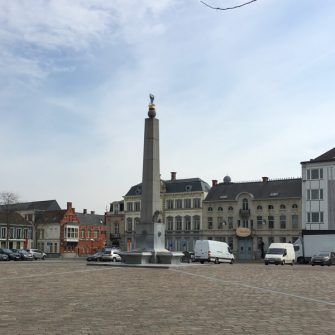
3. Ronse to Oudenaarde: 44-78 km
Ronse’s beautiful market square and surrounding art-deco houses provide a number of cafés and restaurants for a sit-down meal or simply to refuel (more details below).
As you leave the town the Kruisberg then hits you straight away, a 1875m cobbled climb which will test your legs after a café stop at an average gradient of 4% with a maximum of 9%. Four asphalt climbs remain as the journey takes you west to the River Schelde and back north to your starting point.
Hoogberg – 2975m asphalt climb at 3% (max 8%)
Knokteberg – 1100m asphalt descent at 8% (max 13%)
Mont de l’Enclus – 1025m asphalt climb at 7% (max 12%)
Kluisberg – 925m asphalt descent at 6% (max 14%)
A word of warning about Mont de l’Enclus, the penultimate climb of the day – it is a real leg tester. At a whisker over one kilometre long, it has an average pitch of 7% with a maximum of 12%. You will need to hold something in reserve but, once negotiated, you can enjoy a relatively flat 20 kilometres ride back into Oudenaarde where you’ll want to celebrate with a nice, cold Koppenberg beer!
Note: the climb stats in this section are taken from the local tourist board’s guide to the area.
Café stops
The Kwaremont café at the top of the Oude Kwaremont gets great reviews but we didn’t stop as it was so close to the start of the ride. Have you been? Let us know in the comments below.
Brasserie Harmonie, Ronse at 42 kilometres. We chose the Harmonie and sat outside overlooking the square and enjoyed a cheese and ham omelette, followed by apple pie and plenty of coffee.
The Road House, Ronse at 42 kilometres – next door to the Brasserie Harmonie also with outside seating.
Accommodation
We did this ride from our base at the Hotel Leopold in Oudenaarde. It’s a great choice for cyclists – you can read our full review in the “where to stay” section of our guide to cycling in Flanders.
Tips
Read our tips for cycling in Flanders before you set out. Click here for our complete guide to planning a cycling holiday in Flanders.
- We suggest using the town of Ronse as an opportunity to refuel. The Flanders countryside is made up of country lanes, farmland and small rural communities – there are not that many places to stop to eat and drink and we found plenty that were closed when we were there on weekdays in the middle of March.
- Remember when picking your lines on the cobbled roads that they are open to normal vehicular traffic. Often the best line may appear to be on the other side of the road or even on the crown – so you need to remain vigilant.
- The Koppenberg is also very famous in the cyclocross world, for the Belgian Koppenbergcross which takes place each year here.
- You can find tips for the best times of year to visit Belgium, here.
Enjoyed our guide?
We’d love to hear from you – comment below!
Want more? Don’t miss our other guides to the best road cycling routes in the region (red route here, yellow route here) and our tips for cycling in Flanders, below.
Want to check out some other destinations? Take a look at our guide to cycling Brussels or search by the month you want to travel or cycling destination you want to visit, here.
Got a question for John?
Fill out this form and we will send it to John. We aim to get you an answer within 24 hours wherever possible!
The contents of this website are provided for general information purposes only. It is not intended to amount to advice and you should not rely on it. You should carry out your own due diligence and risk assessments and take professional advice. Views expressed by interviewees or other users of this website do not necessarily represent our views. We make no representations, warranties or guarantees, whether express or implied, that the content on our website is accurate, complete or up to date. If you use any information or content on this website, download from, or otherwise obtain content or services through our website, it is entirely at your own discretion and risk. Epic Road Rides Ltd disclaims all liability and responsibility arising from any reliance placed on the information and content on this website. Find out more here.
Like the kit we’re wearing?
We’re proud to be brand ambassadors for Stolen Goat. Their kit is fantastic quality and we love their bold, bright designs. Their customer service is second to none.
Find out how we got to know Stolen Goat and read our candid kit reviews here, or head straight to their site and check them out yourself.
